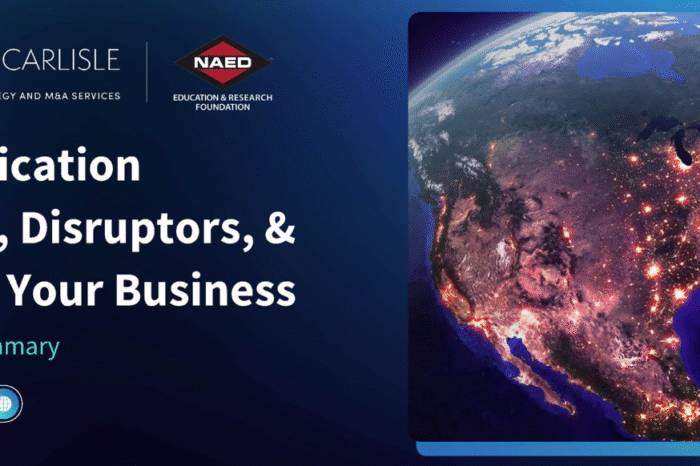Border States, Sonepar, Grew $800M Last Week
 Last week, another $800 million of independent distributor revenue was absorbed by national chains between Border States’ acquisition of Dominion Electric and Sonepar’s acquisition of Standard Electric and Madison Electric, “sister” companies in Michigan.
Last week, another $800 million of independent distributor revenue was absorbed by national chains between Border States’ acquisition of Dominion Electric and Sonepar’s acquisition of Standard Electric and Madison Electric, “sister” companies in Michigan.
The acquisition of $374 million Dominion, which served the Baltimore and Washington, DC markets, by Border States may have surprised some as this was the company’s largest acquisition to date and its first acquisition on the East Coast since it acquired South Carolina-based Shealy. The DC / Maryland market which, 25 years ago was one of the strongest markets for independents is now served by national chains.
It culminates David White’s tenure at Border as White retires as Border States’ CEO this month.
 The acquisition moves Border States over $5 billion and is another stepping stone to helping the company achieve its goal of a presence in every state by 2030. Its ownership structure, an ESOP, is appealing to some sellers who seek that model for their company, or staff. Further, in some markets, the entrance of Border States as an acquirer is welcomed given that national chains may already be in a market.
The acquisition moves Border States over $5 billion and is another stepping stone to helping the company achieve its goal of a presence in every state by 2030. Its ownership structure, an ESOP, is appealing to some sellers who seek that model for their company, or staff. Further, in some markets, the entrance of Border States as an acquirer is welcomed given that national chains may already be in a market.
This deal follows the company’s’ acquisition of Winston Engineering and Sequel Electric. They also recently opened a location(s) in Florida after being rebuffed at Electric Supply in Tampa, where Sonepar outbid them.
Interestingly, recently I’ve been exposed to more regarding ESOPs and their potential in succession planning for owners, facilitating and optimizing ownership exit strategies, utilization of the model for recruitment (retirees as millionaires!), the ability to incent people and as an acquisition vehicle once initial ownership is compensated. With the right management team, and culture, they can be profitable and growth engines … but they need the right management team, as Border States has exhibited it has.
Sonepar’s entry into the Michigan market with the acquisition of Standard and Madison, according to EW a combined $400 million, enables it to “complete” Great Lakes coverage. The deal is contiguous to its Ohio-based acquisitions of Richards Electric and PEPCO.
Richards Electric has since been rebranded as Springfield in Sonepar’s quest for each OpCO to be at least $1 billion. It would not be surprising if, at a point in time, the Standard and Madison companies are integrated into the Springfield brand, which, incidentally, would unite four IMARK distributors (Springfield, Richards, Madison and Standard.)
While the independent ranks lost three distributors last week, two of which were IMARK members and the other an AD member, NAED lost three more independent distributors.
Further, in Q1, and presuming no other deals are announced in the next few days, there have been 10 acquisitions in the electrical distribution market! This isn’t to project that we will have a record breaking 40 deals, but it does highlight that there are still some opportunities, although they are dwindling.
This was brought to mind in speaking recently with an equity analyst who was asking about potential targets for Brad Jacobs’ new venture (QXO) where he intends to acquire companies in the building construction industries. Reportedly he has access to about $2 billion.
As we went down the list of potential companies (now what we’re calling the EW 100), the national chains were not opportunities, then needed to exclude the Rockwell distributors, next there are companies with young ownership / management, and then we eliminated ESOPs (which there are a number that, while could be sold, would be at a premium.) The viable list of significant companies quickly became short.
Recently I looked at the New England market … almost 60% of the business accrues to about 8 distributors, and this was 75-80% of the construction spend in the market.
Channel dynamics are changing. This has implications for manufacturers and reps. Remaining distributors have opportunities, however, they need to be intentional with their growth plans (and partners.) For associations and marketing groups, their dynamics, and roles, are quickly challenged. As someone in a marketing group said this week … “what will the marketing group landscape look like in 5 years as more members are acquired.” Someone else forecasted “In five years, eight distributors will make up 90% of the electrical sales in the US. It is crazy how fast this transition is taking place.”
But, with acquisitions, there are opportunities for those who are impacted and want to stay in the industry. Other distributors see opportunities to strengthen their teams with experienced people, some companies identify opportunities to open new branches, some manufacturer roles may get filled with experienced people, manufacturer reps are able to hire staff.
One thing we do know … change is constant, but talent resurfaces in the industry.
There will be many distributors in the coming years due to the many small distributors currently in the market. The questions will be, “what is their growth opportunity?” and “what is their exit plan?”






















